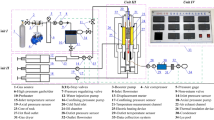Abstract
Enhanced geothermal systems (EGS) have a great potential to extract geothermal energy and have attracted much interest. In this paper, based on a 3D thermal-hydrologic model considering CO2 sequestration, the influences of reservoir heterogeneity and anisotropy on CO2 sequestration and heat extraction in CO2-based EGS are investigated. Different heterogeneous reservoirs and homogeneous reservoir are compared, and different ratios among reservoir permeability components are compared. The results show that greater reservoir heterogeneity enhances CO2 sequestration and restrains heat extraction. Higher ratio between horizontal (x and y directions) and vertical permeability components enhances CO2 sequestration and heat extraction, and vertical permeability component has a little effect. With the increasing ratio between x-directional (perpendicular to the line of the injection well and the production well) and y-directional (perpendicular to x direction) reservoir permeability components (i.e. kx:ky), both CO2 sequestration amount and steady-state heat extraction rate first increase and then decrease, and thermal breakthrough time increases, showing that there exists an optimum kx:ky, which is about 1:1. The results of this paper indicate that reservoir heterogeneity and anisotropy have important influences on CO2 sequestration and heat extraction.
Similar content being viewed by others
References
Zhu J.L., Hu K.Y., Lu X.L., et al., A review of geothermal energy resources, development, and applications in China: Current status and prospects. Energy, 2015, 93: 466–483.
Feng Y., Chen X., Xu X.F., Current status and potentials of enhanced geothermal system in China: A review. Renewable and Sustainable Energy Reviews, 2014, 33: 214–223.
McClure M.W., Horne R.N., An investigation of stimulation mechanisms in enhanced geothermal systems. International Journal of Rock Mechanics & Mining Sciences, 2014, 72: 242–260.
Watanabe N., Wang W., McDermott C.I., et al., Uncertainty analysis of thermo-hydro-mechanical coupled processes in heterogeneous porous media. Computational Mechanics, 2010, 45: 263–280.
Xu C., Dowd P.A., Wyborn D., Optimisation of a stochastic rock fracture model using Markov Chain Monte Carlo simulation. Mining Technology, 2013, 122(3): 153–158.
Alghalandis Y.F., Dowd P.A., Xu C., The RANSAC method for generating fracture networks from microseismic event data. Mathematical Geosciences, 2013, 45: 207–224.
Vogt C., Kosack C., Marquart G., Stochastic inversion of the tracer experiment of the enhanced geothermal system demonstration reservoir in Soultz-sous-Forets—Revealing pathways and estimating permeability distribution. Geothermics, 2012, 42: 1–12.
Vogt C., Klitzsch N., Rath V., On self-potential data for estimating permeability in enhanced geothermal systems. Geothermics, 2014, 51: 201–213.
Chen J.L., Jiang F.M., Designing multi-well layout for enhanced geothermal system to better exploit hot dry rock geothermal energy. Renewable Energy, 2015, 74: 37–48.
Benim A.C., Cicek A., Eker A.M., A computational investigation of the thermohydraulics of an EGS project. Journal of Thermal Science, 2018, 27(5): 405–412.
Taron J., Elsworth D., Min K.B., Numerical simulation of thermal-hydrologic-mechanical-chemical processes in deformable, fractured porous media. International Journal of Rock Mechanics & Mining Sciences, 2009, 46: 842–854.
Doe T., McLaren R., Dershowitz W., Discrete fracture network simulations of enhanced geothermal systems. Proceedings in 39th Workshop on Geothermal Reservoir Engineering, Stanford, California, 2014.
Pandey S.N., Chaudhuri A., Rajaram H., et al., Fracture transmissivity evolution due to silica dissolution/precipitation during geothermal heat extraction. Geothermics, 2015, 57: 111–126.
Huang W.B., Cao W.J., Jiang F.M., Heat extraction performance of EGS with heterogeneous reservoir: A numerical evaluation. International Journal of Heat and Mass Transfer, 2017, 108: 645–657.
Kalinina E., McKenna S.A., Hadgu T., et al., Analysis of the effects of heterogeneity on heat extraction in an EGS represented with the continuum fracture model. Proceedings in 37th Workshop on Geothermal Reservoir Engineering, Stanford, California, 2012.
Hadgu T., Kalinina E., Lowry T.S., Modeling of heat extraction from variably fractured porous media in Enhanced Geothermal Systems. Geothermics, 2016, 61: 75–85.
Llanos E.M., Zarrouk S.J., Hogarth R.A., Numerical model of the Habanero geothermal reservoir, Australia. Geothermics, 2015, 53: 308–319.
Zimmermann G., Reinicke A., Blöcher G., et al., Well path design and stimulation treatments at the geothermal research well GtGrSk 4/05 in Groß Schönebeck. Proceedings in 32nd Workshop on Geothermal Reservoir Engineering, Stanford, California, 2007.
Wang C.L., Cheng W.L., Nian Y.L., et al., Simulation of heat extraction from CO2-based enhanced geothermal systems considering CO2 sequestration. Energy, 2018, 142: 157–167.
Cheng W.L., Wang C.L., Nian Y.L., et al., Analysis of influencing factors of heat extraction from enhanced geothermal systems considering water losses. Energy, 2016, 115: 274–288.
Cheng W.L., Li T.T., Nian Y.L., et al., Studies on geothermal power generation using abandoned oil wells. Energy, 2013, 59: 248–254.
Cheng W.L., Huang Y.H., Lu D.T., et al., A novel analytical transient heat-conduction time function for heat transfer in steam injection wells considering the wellbore heat capacity. Energy, 2011, 36: 4080–4088.
Nian Y.L., Cheng W.L., Insights into heat transport for thermal oil recovery. Journal of Petroleum Science and Engineering, 2017, 151: 507–521.
Chen Y.L., Zhu M.M., Physical fluid dynamics. Press of University of Science and Technology of China, Hefei, 2008.
Jiang F.M., Chen J.L., Huang W.B., et al., A three-dimensional transient model for EGS subsurface thermohydraulic process. Energy, 2014, 72: 300–310.
Pan C., Chavez O., Romero C.E., et al., Heat mining assessment for geothermal reservoirs in Mexico using supercritical CO2 injection. Energy, 2016, 102: 148–160.
Nathenson M., The dependence of permeability on effective stress from flow tests at hot dry rock reservoirs at Rosemanowes (Cornwall) and Fenton Hill (New Mexico). Geothermics, 1990, 28: 315–340.
Acknowledgments
The authors would like to thank the National Natural Science Foundation of China (51478001) and the Natural Science Foundation of Anhui Province (1808085QE178) for the financial support.
Author information
Authors and Affiliations
Corresponding author
Rights and permissions
About this article
Cite this article
Wang, C., Huang, Z., Lu, Y. et al. Influences of Reservoir Heterogeneity and Anisotropy on CO2 Sequestration and Heat Extraction for CO2-Based Enhanced Geothermal System. J. Therm. Sci. 28, 319–325 (2019). https://doi.org/10.1007/s11630-019-1064-1
Received:
Published:
Issue Date:
DOI: https://doi.org/10.1007/s11630-019-1064-1




